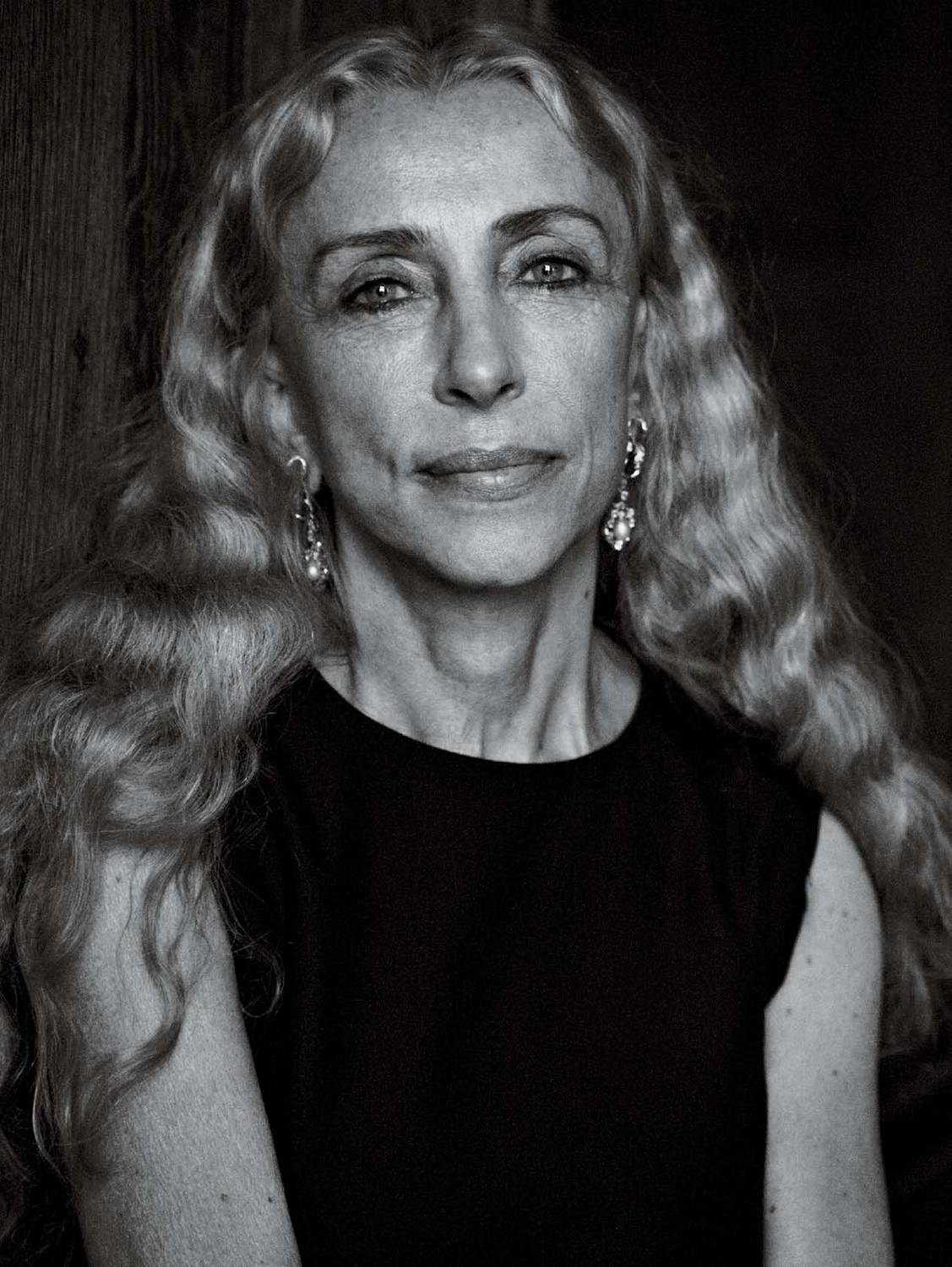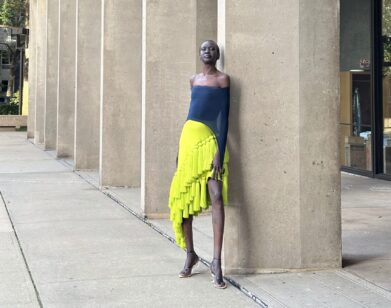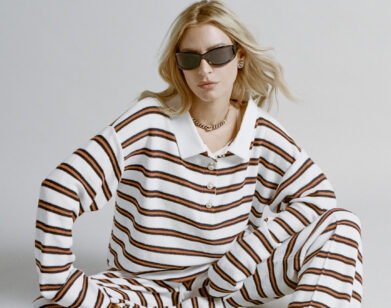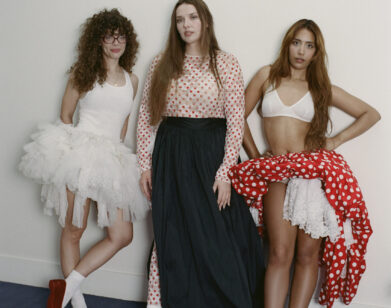Franca Sozzani
Everybody can give me their suggestions, but at the end, the Final risk is mine because it’s my name on the magazine. i listen, but i must go my own way.Franca Sozzani
Franca Sozzani, the powerhouse behind Italian Vogue, has made a singular mark on the world of fashion over the last 30 years. After serving as an editor at both Vogue Bambini and the influential Italian fashion magazine Lei, Sozzani took over Italian Vogue in 1987, and since then, has transformed the magazine into a platform for celebrating the power of the image and of photography. In the process, she has helped reimagine the medium of the fashion magazine as a kind of cultural lightning rod, and has consistently used both fashion and fashion imagery as a vehicle for tackling social, political, and even environmental issues.
Sozzani herself has served as a bit of a lightning rod, always capturing, recording, and at times preempting the zeitgeist. In the ’90s, she helped create the phenomenon of the supermodel with one of her closest long-term collaborators, Steven Meisel, and she has championed a tight-knit group of photographers such as Bruce Weber, Peter Lindbergh, and Paolo Roversi, working with them to develop a visual language for the magazine that continues to provide a mood board for the moment. Sozzani’s controversial 2008 “Black” issue, which featured only black models, was hotly debated and dissected both within the fashion world and beyond it, reigniting the conversation about racial diversity in fashion. In the aftermath of the BP spill in 2010, she published a story featuring model Kristen McMenamy wearing a fur coat and covered in oil. She has commissioned provocative studies of subjects such as the paparazzi and rehab clinics that have fearlessly taken on the obsessions, addictions, and crises of contemporary culture with a lightness and humor that only serves to magnify the message behind them.
Documentary film producer and sustainability advocate Livia Firth recently spoke with Sozzani, who had just returned to Milan after a busy Couture Week in Paris, about the risks and the rewards of being one of fashion’s great darers, her latest passion, and how her own relationship to fashion has evolved over her three-decade career.
LIVIA FIRTH: The first time that I came to your office, you reminded me a bit of a leopard with your eyes and your stance. You stared at me at first, trying to understand who I was, and you listened, but there was an intensity in your eyes, and I was quite scared. [laughs] But then by getting to know you better, I discovered a woman who was fun and mischievous and incredibly curious about everything. What do you think is the difference between the perception that people have of you—the public Franca Sozzani—and who you really are? Is there a difference between the two?
FRANCA SOZZANI: I make a difference. I think in a way there’s almost a choice, you know? I don’t think when you work you have to please everybody—you make a choice. It’s not like everybody who is in front of you has to become your best friend. You can be easy, you can be nice . . . But I always keep my guard up. Only when I know people can I open myself up, so sometimes I even get called shy. I need to protect myself from everybody. I see so many people all day, all demanding their own jobs, their own opportunities, so in a way, I make a distinction. I’m very difficult about opening myself up with people at first . . . It just takes time.
FIRTH: You are famous for being a risk taker. You did a “Black” issue, you did a “curvy” issue, and people call you a rebel. Do you think of yourself as a rebel? Or does this have more to do with having curiosity and a willingness to explore?
SOZZANI: I think I just do what I feel is good to do. Everybody can give me their suggestions, but at the end, the final risk is mine because it’s my name on the magazine. So I only do what I really feel. Everybody tries to influence you, of course: “Oh, this is the right moment to do this” and “This is the right photographer to choose,” and “This is the right model to have . . .” I listen, but I must go my own way. When you take risks, it means that you know every month people are there to judge you. Some months are good; some months are bad. When you make a mistake, they call you immediately. And when you do something good, they send flowers to the stylist. So this is a way to say that I want to do it myself. I don’t care if you like it or not. I do the magazine that I think is correct. If you like this issue, I am more than happy. If you don’t like this issue, you will like the next because we do 14 issues a year. So once in a year you will love, no? I’m very independent.
FIRTH: You are very independent. You’ve also had a long history of encouraging young people—you love new talent. In fact, you’ve actually opened the doors of Italian Vogue in Milan for two years in a row now to more than a thousand young people to meet with you and your staff. How did that work? Did each one of them have some time with you?
SOZZANI: It was very intense because you’ve got 1,500 people in two afternoons. So it was very fast. People would be very calm and cool, all very well dressed. They were coming to the Vogue office . . . But what’s strange is that everybody has a different question. It’s not all like, “How do you be a fashion editor?” or “I want to be an writer.” It’s like, “I want to take a good picture” or “I like this look—what do you think is good?” They come to you not to have an answer for their lives but to have an answer for that moment. I’m not the prince of China, so it’s not like they come and I say, “Oh, you will have a life in Vogue.” But when you try to support somebody, you know that you have to be careful of the words that you use. So in a very quick way, I’m like, “No, no, don’t do commercial. Go this way,” or “You are very good at doing commercial. Don’t be scared to do commercial. It’s not a bad word.” You know, it was different intentions for every person. And all these people today—they write, they see, and they follow the blogs . . . So that’s interesting.
FIRTH: Most magazines have different editors for online, but you are very much the core of both the print and the online versions of Italian Vogue. How do you think you have had to change the magazine with the evolution of the Internet?
SOZZANI: I thought Italian Vogue had always been considered the most experimental, avant-garde magazine. If I was going to use the same kind of language and the same kind of photos or images on the web site, it would be a disaster because Vogue has its own world, and it could be a little bit cold, you know? We don’t give what you call a service—you know, like, how to get your husband to do something or how to do well in school. We don’t do anything like that. It’s all about a vision, an aesthetical interpretation of a reality that you can sway. And I understood that this language could be a very wrong way to communicate with people through the Web site. So I decided to follow the web site and to change the language, keeping it visually as strong as the magazine but talking to readers, creating a connection with them, because sometimes through the magazine—through the news, the gossip, the parties, the fashion shows, the interpretations—you don’t make a connection. You need photo blogs in which the young readers can post their own pictures, or a challenge for young designers. Everybody is starting their own line now, posting their own pieces on the fashion blogs and in videos through the leading Web sites, so all these things are destined to make them closer to me. Otherwise, they might think that I am uptight, unhelpful, aggressive, and very vile because I don’t have this human way to talk to them or even an ironical way to answer their questions because I’m such . . . You know, I can be very tough in my answers, and that was good for the magazine because it didn’t mix focus points—it was to be extravagant, experimental, innovative. But the web site has made it more human. So the Web site is good for the magazine.
FIRTH: Through the magazine, you have also started to do your social work. Some people seem to think that the fact that you are engaged with social work and activism clashes with the ephemeral world of fashion. But fashion can be a very strong weapon to achieve a kind of social justice. Do you struggle to reconcile these two aspects of your work?
Franca is one oF the smartest people i know. she is unaFraid to dare and push the envelopeDonatellaa Versace
SOZZANI: No, because first of all, I think in any work you need to be creative. Even in a factory, even in a colony, you need to be creative. So in fashion you need to be creative, but you need to be more than creative because it’s a business, which you should not forget. So if you mix that creativity and a stellar business, and you bring that experience to a new world where they don’t know anything about it, you really teach them something new.
FIRTH: How did you become a goodwill ambassador for Fashion 4 Development? I know it’s a global campaign which, through fashion-based initiatives, is designed to support the U.N.’s other work in areas like poverty and gender equality, but can you talk a little bit about your involvement with this project?
SOZZANI: I really understood that my commitment should be a commitment—not only an honorable title before my name. The mission is to really use my know-how, my experience, and my willpower to help produce more work and education. I do not believe that you can help anyone in the world without giving them an education, a salary, and work for their education. Because when you have a salary, you feel like you are a human being who has been recognized by society. If you don’t have a salary, then you are always somewhat rejected by society. So we have to create this project in a way to give people an appropri- ate salary and to have a place where they have dignity. They need to be prepared, because, you know, some of them cannot do this kind of work—they are not skilled, so we need to train them. The idea is to create a small laboratory in which, at the same time, you learn, you produce, and you have a family.
FIRTH: I remember you telling me after you became a goodwill ambassador that you actually wanted to work at it.
SOZZANI: Well, the people that I met—they were so sharp. Usually, a goodwill ambassador goes out and says, “Oh, hello, how are you? Poor kids . . .” And I said, “No, I really want to work. I really want to produce. I really want to make business. I want to bring in money. I want them to involve me with a project, and I’m covering it in a special issue. That way, people can see that it’s not Hollywood.” Everybody, of course, was shocked, and now they see that I already went to Ghana and I went to Nigeria. The magazine is going to honor . . . We did an auction to raise development money. Now, the culture is much more involved than before. In the beginning, it was words, words, words. But now we have action, you know?
FIRTH: Did your trip to Africa change your perception of fashion at all?
SOZZANI: It didn’t change my idea of fashion, but you know what it did change? It changed my attitude. I’m really very committed. I drove all day long to meet people, to try to convince people, and at the same time, I feel that I cannot do anything by myself. I feel that I can select people to do my work, and I can do a lot of dinners and help bring attention. But being in those countries . . . I’m just observing now, but it won’t be easy to change the situation. So more than changing my feelings about fashion, doing this work has changed my feeling about my potential and my possibilities to do something. I’m a Capricorn. I feel that I have to be stronger. I cannot be only “Yes, we can do it”—it’s “Yes, we have to do it.” So I’m doing the fashion shows, doing the couture, and I was looking and thinking, “We do something like this with these people, but what can we do to use all these people—the news, press people, and families—to help them understand?” You know, I’m changing my mentality . . . It’s a new thing. [laughs]
FIRTH: You mentioned the fact that even in charity you need to be committed to creating. That’s why I got involved with the Green Carpet Challenge, which is an ongoing project that encourages celebrities to wear eco-friendly clothing on the red carpet, and which you know about because you are now a part of it. Maybe I should know the answer to this, but why did you decide to get involved?
Franca is an extraordinary woman. she has an amazing eye for spotting talent and the courage to use it. her magazine and everything she does is a source of inspirationDiane Von Furstenberg
SOZZANI: You know, when you came to me the first time, you were being real hard on me. You were like, “You know, people in fashion—they understand nothing. What others do to the dress is not that important. What about the trade and what’s behind this system?” I understand that it’s how you talk with people. [laughs] So one night you talked about this, and in the beginning I didn’t exactly get the point, but then I got it when you were saying, “Well, if you wear a dress that is eco, it’s not that the attire should call attention, but people will say, ‘Look at her—she has such a beautiful dress.’ And that’s when you say, ‘Did you know that this dress is made with fair-trade ecological sustainability?’” Now we’re playing with the world, and the world, in a way, is like a boomerang, you know? The world is changing. Everything is going bad; something’s wrong around us. So one night you talked about this, and we started working on it together . . . It’s an education. We need to educate people. It’s not to be cool or spiritual, all “We want to save the world!” But you can do it in a different way. I think that we’ve become a very visual culture, and once the people understand that a project like this is not only about beauty but about sustainability, then that’s even better. People will eventually see it like us. But at the moment, they don’t understand, so we have to bring them into it.
FIRTH: Frankly, that’s what happened with the Armani dress [which Firth wore on the red carpet while accompanying her husband, the actor Colin Firth, to the 2012 Golden Globes] That’s a good dress made by a designer. It’s an incredibly beautiful dress. But then when you have the story about the fabric and how it’s made of recycled plastic and who made it and how they made it, suddenly people reconnect to it. Lucy Siegle, the British journalist who co-founded the Green Carpet Challenge with me, wrote a book called To Die For: Is Fashion Wearing Out the World? She goes deep into the factories and the production chains and the issue of sustainability. Have you ever been to a factory in Bangladesh or India or China?
SOZZANI: Yes.
FIRTH: How can fashion not ruin our world?
SOZZANI: I don’t want fashion to wear out the world. Do you know what the main problem is when you read about these kinds of factories like in Namibia or even in Morocco, where there is so much criminal behavior? They just produce for the tourists. They produce for the people who come there, and they want to pay one euro because they think that the work has no value. It drives me crazy. All these people just work like crazy to make a shawl or all those bowls, and after they run after you and they say, “Ten euros! No, nine! No, eight, seven, six, five . . .” Come on, it’s purely insulting. So the work that the workers do has to be protected—that’s what I said when I met the presidents in Nigeria and in Ghana. I told them, “We have to protect your art. You have to protect your culture. You have to protect your ability to create, and we need to work together to find a solution so the Western people don’t feel like they’re buying something like when you buy from India or Bangladesh or Peru because there is no respect for these countries from our side—not for those poor guys. They work very hard, but we do not respect the work.
FIRTH: If you find a label on your garment that says, “Made in India,” or “Made in Bangladesh,” you evaluate it immediately: “Why was this made in that place?”
SOZZANI: It’s already over. You pretend that it’s completely inexpensive.
FIRTH: Yes. Because one of the big problems is also what is called “fast fashion,” which is one of the plagues of the last 10 years. It has changed the entire perception that people have of fashion. What do you think is the future of fashion?
SOZZANI: The future of fashion? I think it’s more and more separated—like, on one side would be big distribution, and on the other side there will be high-level prêt-à-porter and couture. I mean, the prêt-à-porter is already couture in a way for the prices and the way that it’s made. The big distribution will allow people to dress in a fashionable way, so this could be for everybody. This part of the big distribution will be stronger and stronger, but the other part we are coming up on is more and more rich people, because we’re always thinking about Europe and about America, but we are forgetting that markets have opened up in modern China, India, and, who knows, maybe even Africa. And so it will be on one side very sophisticated and very unique and very precious, and on the other side, it will be about very big distribution. I think what we have to do is try to protect every country . . . I am trying to go to Africa to see everything that they do and produce in China and send back to Africa. I think that Africa really needs to protect themselves more—more than we can do from the outside. We can’t do it for them. They have to do it alone to make it.
FIRTH: It’s the same with the World Trade Organization. I was talking to them about better trade routes because this has been a problem. There have been complications with coffee and chocolate for a long, long time.
SOZZANI: It’s everything. Everything.
FIRTH: It’s everything, exactly. Let’s talk about feminism. I know you studied philosophy when you were younger, and you speak four languages, and you’re a very strong woman, but at the same time you live in a very glamorous world with all the parapherna- lia that that world brings. Some women are able to have both of those aspects of their lives—and even use it to their advantage— but others find it contradictory. Do you think sometimes that feminism ever gets in the way?
SOZZANI: I think that you are younger than me, so maybe you don’t know, but I was living in the moment that feminism came out of, and I think it’s only through the work that women are doing today that they are making out better than men. So it’s important that you are a feminist in your mind but that you have an attitude sometimes like men. I mean, when I was younger I wanted to be a feminist, and I thought, “So you should be a bad dresser—really shabby, bad hair and makeup.” Everything that was feminine was rejected. But you learn that if you are glamorous, if you are very well dressed, if you are human, you can arrive. Because in the moment in which I am better than a man in my work, I already show everybody that women can do better—I don’t have to dress a certain way to show that . . . The world is not in favor of the women. It’s pretty dramatic.
FIRTH: Let’s do some quick ones, Franca. What would you like to learn next?
SOZZANI: I would like to go to China and explain my point of view . . . I would also like to learn how to make a movie.
FIRTH: What inspires you?
SOZZANI: Everything. It could be a movie. It could be a book. It could be a house. It could be one word— I’ll think for hours and hours about one word sometimes. It could be anything.
FIRTH: Who inspires you?
SOZZANI: People who are interesting. It doesn’t matter if they are beautiful or not beautiful—interest- ing people. Do you know when you go to a very boring dinner and you sit down and you have the chance to talk with somebody and it’s so interesting that you learn so much that night that you go back and say, “Oh, finally, I met someone who inspired me”? I love that. It could even be parts of a person—the way that they exclaim, their dream.
FIRTH: How do you challenge yourself?
SOZZANI: I like to be risky every day, changing minds every day. I’m not reliable at all in my ideas. I can change my ideas three times a day. I change different things, the parts of the content. But I never change the content of who I am. So my challenge every day is to change and to take risks.
FIRTH: What is your relationship with men and sex? We need to talk about the sex, too.
SOZZANI: [laughs] Very good.
FIRTH: We couldn’t be having a conversation between two women and not talk about sex for a little bit. Because you travel a lot, and you are never in the same place for more than a day, do you have a—
SOZZANI: No. You know what? I already got married a few times. I had a fantastic husband.
FIRTH: So you’ve had enough?
SOZZANI: I didn’t need to get married again. It’s great to be in a situation in which you’re happy. But, you know, I’m not tortured by love. I’m not tortured by chagrin d’amour. I’m old now.
FIRTH: What is your relationship with your son?
SOZZANI: It’s a very good relation because there is a mutual estimation between us, you know? He believes me, and I trust him, and we share a lot of things in common, like movies, books. We have more a relation like . . . I don’t want to say two friends, because it’s always my son and I’m always his mother, and when I want to be his mother, I’m his mother. I don’t want to be his friend. But we have a very good relation—more like an aged person and a young person. He did philosophy too, so it’s really good. You know what? It’s a very grown-up relation.
FIRTH: What is your relationship with money?
SOZZANI: Quite bad. Very bad. Very bad because, for me, money is to use—it’s only to use. So I never have money because I always spend. That’s why in a way I protect myself in having houses. But if I had just cash or kept it in the bank, I’d spend it immediately. But not for stupid things. [laughs] So I don’t like to have money. I never have money in my pocket.
FIRTH: Last question: You have a magazine. You run a magazine online. You are a goodwill ambassador. You travel all the time, you go out, you meet people. What is the secret of doing it all? How do you do it?
SOZZANI: I think that I’m still very enthusiastic about every single thing that I do. I’m still very passionate. I never feel tired because I feel so involved and so com- mitted, so I enjoy it. And you know what? I have a lot of irony. I love the humor, and when I really, really want to just say, “You know what? I can’t stand all this,” I find an ironical way. I say, “You know, maybe you presume to be more intelligent than you are.” So I respond in a more humoristic way.
Livia Firth is a documentary film producer and the Creative Director of Eco Age.







